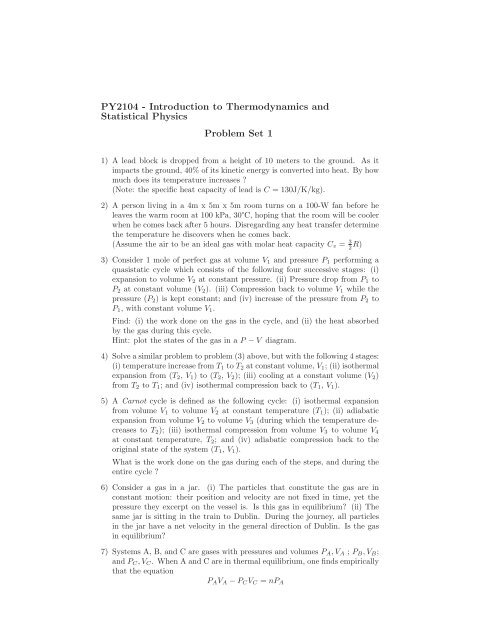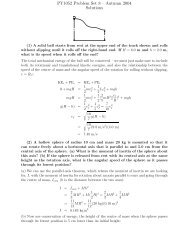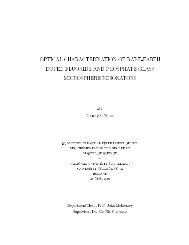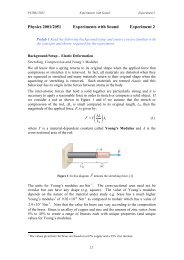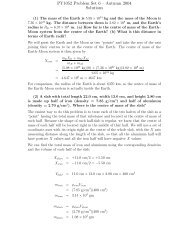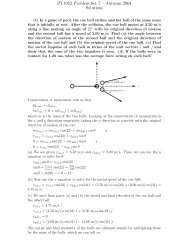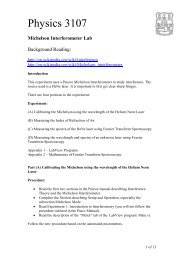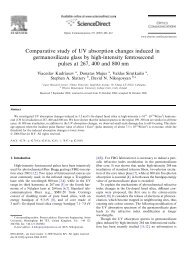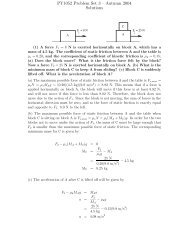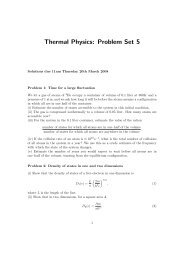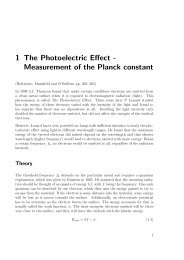PY2104 - Introduction to Thermodynamics and Statistical Physics ...
PY2104 - Introduction to Thermodynamics and Statistical Physics ...
PY2104 - Introduction to Thermodynamics and Statistical Physics ...
You also want an ePaper? Increase the reach of your titles
YUMPU automatically turns print PDFs into web optimized ePapers that Google loves.
<strong>PY2104</strong> - <strong>Introduction</strong> <strong>to</strong> <strong>Thermodynamics</strong> <strong>and</strong><strong>Statistical</strong> <strong>Physics</strong>Problem Set 11) A lead block is dropped from a height of 10 meters <strong>to</strong> the ground. As itimpacts the ground, 40% of its kinetic energy is converted in<strong>to</strong> heat. By howmuch does its temperature increases ?(Note: the specific heat capacity of lead is C = 130J/K/kg).2) A person living in a 4m x 5m x 5m room turns on a 100-W fan before heleaves the warm room at 100 kPa, 30°C, hoping that the room will be coolerwhen he comes back after 5 hours. Disregarding any heat transfer determinethe temperature he discovers when he comes back.(Assume the air <strong>to</strong> be an ideal gas with molar heat capacity C v = 3 2 R)3) Consider 1 mole of perfect gas at volume V 1 <strong>and</strong> pressure P 1 performing aquasistatic cycle which consists of the following four successive stages: (i)expansion <strong>to</strong> volume V 2 at constant pressure. (ii) Pressure drop from P 1 <strong>to</strong>P 2 at constant volume (V 2 ). (iii) Compression back <strong>to</strong> volume V 1 while thepressure (P 2 ) is kept constant; <strong>and</strong> (iv) increase of the pressure from P 2 <strong>to</strong>P 1 , with constant volume V 1 .Find: (i) the work done on the gas in the cycle, <strong>and</strong> (ii) the heat absorbedby the gas during this cycle.Hint: plot the states of the gas in a P −V diagram.4) Solveasimilarproblem<strong>to</strong>problem(3)above, butwiththefollowing4stages:(i) temperature increase from T 1 <strong>to</strong> T 2 at constant volume, V 1 ; (ii) isothermalexpansion from (T 2 , V 1 ) <strong>to</strong> (T 2 , V 2 ); (iii) cooling at a constant volume (V 2 )from T 2 <strong>to</strong> T 1 ; <strong>and</strong> (iv) isothermal compression back <strong>to</strong> (T 1 , V 1 ).5) A Carnot cycle is defined as the following cycle: (i) isothermal expansionfrom volume V 1 <strong>to</strong> volume V 2 at constant temperature (T 1 ); (ii) adiabaticexpansion from volume V 2 <strong>to</strong> volume V 3 (during which the temperature decreases<strong>to</strong> T 2 ); (iii) isothermal compression from volume V 3 <strong>to</strong> volume V 4at constant temperature, T 2 ; <strong>and</strong> (iv) adiabatic compression back <strong>to</strong> theoriginal state of the system (T 1 , V 1 ).What is the work done on the gas during each of the steps, <strong>and</strong> during theentire cycle ?6) Consider a gas in a jar. (i) The particles that constitute the gas are inconstant motion: their position <strong>and</strong> velocity are not fixed in time, yet thepressure they excerpt on the vessel is. Is this gas in equilibrium? (ii) Thesame jar is sitting in the train <strong>to</strong> Dublin. During the journey, all particlesin the jar have a net velocity in the general direction of Dublin. Is the gasin equilibrium?7) Systems A, B, <strong>and</strong> C are gases with pressures <strong>and</strong> volumes P A ,V A ; P B ,V B ;<strong>and</strong> P C ,V C . When A <strong>and</strong> C are in thermal equilibrium, one finds empiricallythat the equationP A V A −P C V C = nP A
is satisfied. When B <strong>and</strong> C are in equilibrium, the relationholds. Here, n <strong>and</strong> n ′ are constants.P B V B −P C V C = − n′ P C V CV B(i) What are the three functions of state which are equal <strong>to</strong> one another atthermal equilibrium? Argue that these functions can be called “the empiricaltemperature”, T . Is any of these gases ideal?(ii) What is the relation expressing thermal equilibrium between gases A <strong>and</strong>B ?


